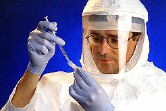FRIDAY, March 18, 2016 (HealthDay News) — Regular exercise could help boost the survival of people who’ve left the hospital after battling chronic obstructive pulmonary disease (COPD), a new study finds.
“We know that physical activity can have a positive benefit for people with COPD and these findings confirm that it may reduce the risk of dying following hospitalization,” study lead author Dr. Marilyn Moy, assistant professor of medicine at Harvard Medical School, said in a news release from ERJ Open Research.
Her team published the findings in the journal on March 16.
COPD includes emphysema, chronic bronchitis or a combination of the two, and is often related to smoking. Common symptoms include difficulty breathing, chronic cough, wheezing and phlegm production. Over time, the condition can prove fatal.
One expert, Dr. Alan Mensch, noted, “COPD is estimated to affect up to 7 percent of adults and is a leading cause of death worldwide.”
He explained that “difficulty breathing often leads to a sedentary lifestyle in COPD patients, resulting in deconditioning of multiple organ systems, including the heart and muscles.
“Improving muscle function with exercise has been demonstrated to decrease the use of health services in patients with COPD,” said Mensch, who is chief of pulmonary medicine at Northwell Health’s Plainview Hospital in Plainview, N.Y.
The new study’s authors also said that the risk of hospital readmission and death is especially high after a person has been hospitalized for COPD.
Could exercise help lower that risk? To find out, Moy’s team looked at the medical records of almost 2,400 people in California who were hospitalized for COPD.
The researchers found that those who did any amount of moderate to vigorous physical activity were 47 percent less likely to die in the 12 months after hospitalization than inactive patients.
In fact, low levels of physical activity reduced the risk of death by 28 percent, the researchers report.
Because of the observational nature of the study, the findings can’t prove cause and effect. However, the researchers believe that tracking physical activity levels might be a good way for doctors to pinpoint those COPD patients at high risk for death after hospitalization.
According to Mensch, “COPD has now joined other chronic diseases, including type 2 diabetes and cardiovascular conditions, where exercise has been shown to decrease mortality and prolong life.”
He says the finding is especially valuable in regards to COPD, because doctors have little to offer patients to help lower disease-linked death risk.
“It is gratifying to learn that we can now offer therapy in the form of exercise, which will prolong the lives of patients with COPD,” Mensch said.
Dr. Len Horovitz is a pulmonary specialist at Lenox Hill Hospital in New York City. He noted that in the study, even patients who were “minimally active” still gained a 28 percent reduction in their odds of dying within the study period.
“It is widely known that activity can avoid microscopic lung collapse,” Horovitz said, “and that sedentary patients have a greater risk for developing blood clots and fatal pulmonary embolism [clots].”
More information
The American Academy of Family Physicians has more on COPD.
Copyright © 2025 HealthDay. All rights reserved.

